Checking out the Future of Automation Testing in Software Application Growth
Checking out the Future of Automation Testing in Software Application Growth
Blog Article
From Manual to Automated Testing: A Comprehensive Guide to Transitioning Efficiently and Effectively
In the world of software testing, the shift from handbook to automated procedures has ended up being a progressively essential change for organizations looking for to enhance performance and accuracy in their screening techniques. The journey from manual to automated screening is not without its difficulties, but when come close to purposefully and with a clear plan in mind, the advantages can be substantial.
Benefits of Automated Testing
Automated screening supplies numerous advantages, enhancing efficiency and accuracy in software application development processes. Automated tests can be run concurrently on numerous tools and running systems, drastically speeding up the testing phase compared to manual screening.
Furthermore, automated testing makes certain a greater level of precision in identifying flaws. Uniformity in screening is also boosted, as automated tests execute the very same steps precisely each time they are run.
Picking the Right Tools

To start with, evaluate your requirements and objectives. Recognize the extent of your task, the innovations included, and the capability of your group. This evaluation will certainly assist you figure out the capabilities and attributes you need in your testing tools.
Second of all, think about the compatibility of the tools with your existing processes and systems. Smooth assimilation with your present software application growth lifecycle is important to make certain a smooth change to automation.
In addition, examine the scalability and versatility of the tools. As your screening needs advance, the devices must be able to adjust and accommodate adjustments properly.
Finally, consider the support and community around the tools. When implementing automated screening, robust support and an energetic individual area can offer beneficial resources and aid. By very carefully considering these facets, you can select the right devices that straighten with your requirements and established the stage for a successful change to automated testing.
Composing Reliable Test Scripts

When crafting test manuscripts, it is vital to take into consideration the particular needs of the software program being tested and make certain that the scripts resolve all essential performances. Detailed and clear naming conventions for examination manuscripts and test instances can enhance readability and maintainability. In addition, incorporating mistake handling systems within the examination manuscripts can help in determining and addressing problems without delay.
Additionally, arranging examination scripts into modular elements can boost reusability and scalability, reducing redundancy and boosting efficiency in examination script upkeep. Normal reviews and updates to evaluate scripts are critical to keep pace with progressing software program needs and functionalities. By following these principles, testers can create reliable and Continued durable examination manuscripts that contribute significantly to the success of automated testing processes.
Integrating Automation Into Workflows
Effective combination of automation devices into existing workflows improves and improves processes efficiency within software application growth cycles. When including automation right into process, it is important to identify recurring jobs that can be automated to save time and reduce human error. By perfectly incorporating automated screening devices like Selenium or Appium into the software application advancement lifecycle, groups can attain faster responses on code modifications, causing quicker insect detection and resolution. This integration permits continual screening throughout the advancement process, making certain that any kind of concerns are recognized early, leading to higher software high quality. Additionally, automation can be used to cause examinations immediately after each code commit, giving instant validation and liberating testers to concentrate on more facility situations. Proper assimilation of automation tools requires partnership between growth, testing, and procedures teams to develop a unified operations that optimizes efficiency and effectiveness in providing top notch software application items.
Making Certain a Smooth Transition
Successfully transitioning to automated screening entails meticulous planning and cautious implementation to make the most of and lessen disturbances performance in the software development process - automation testing. To guarantee a smooth shift, it is important to start by conducting a complete analysis of the present screening procedures and recognizing locations where automation can bring one of the most substantial advantages. Involving with all stakeholders beforehand in the procedure, consisting of programmers, testers, and task supervisors, is crucial for garnering assistance and buy-in for the automation campaign
Interaction is crucial throughout this change stage. Clear communication of the goals, benefits, and expectations of automated testing aids to take care of any kind of why not try this out resistance or problems that might develop. In addition, supplying appropriate training and sources for group members to upskill in automation tools and techniques is vital for ensuring an effective change.

Conclusion
To conclude, transitioning from manual to automated testing provides many advantages, consisting of boosted performance and integrity. By selecting the proper devices, composing efficient test scripts, and integrating automation effortlessly right into process, organizations can make sure a smooth and effective shift. It is vital to welcome automation as a valuable property in software screening procedures to enhance general high quality and productivity.
In the realm of software screening, the shift from manual to automated processes has actually ended up being an increasingly important transition for companies looking for to improve efficiency and accuracy in their screening methods. Automated tests can be run at the same time on multiple tools and running systems, dramatically speeding up the testing phase contrasted to hands-on screening. Consistency in testing is additionally enhanced, as automated tests implement the exact same steps specifically each time they are run.To make sure the successful execution of chosen testing devices, the development of effective examination scripts plays a critical duty in verifying the functionality and efficiency of automated processes - automation testing. By adhering to these discover here principles, testers can develop efficient and robust examination scripts that add substantially to the success of automated testing procedures
Report this page